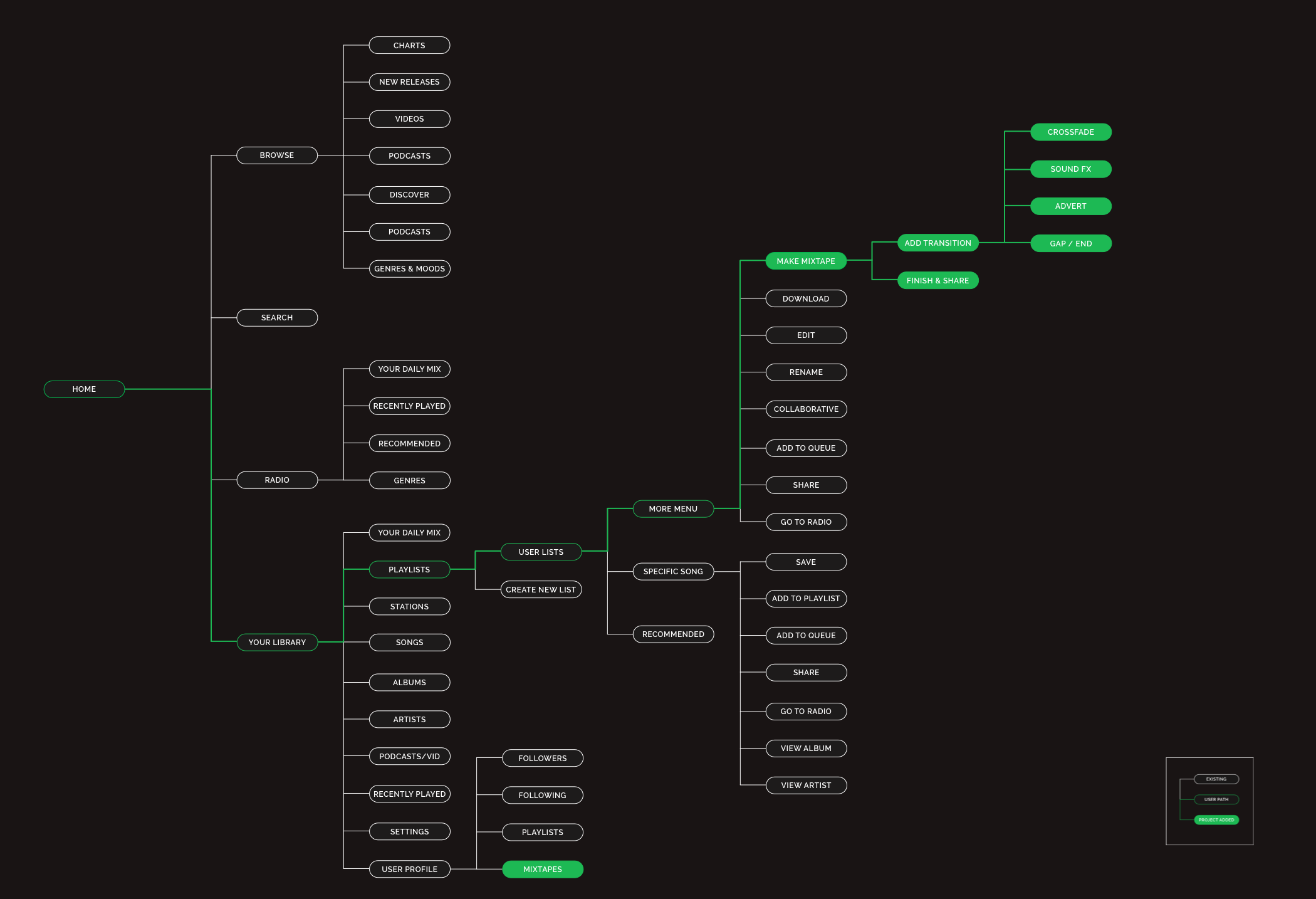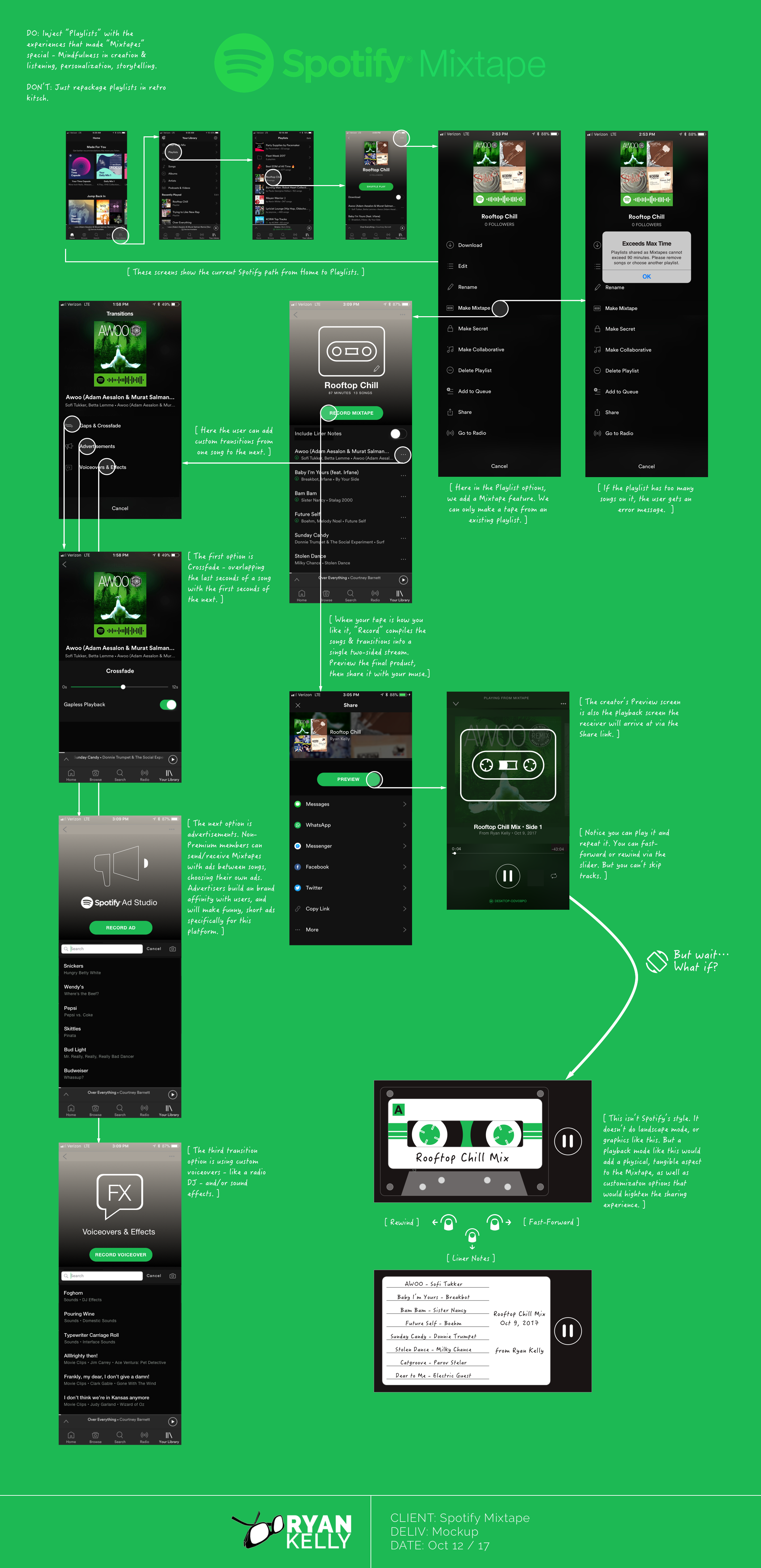Case Study 3
Could Spotify Save the Mixtape?
Spotify wants to enhance music sharing among users.
Enter: The most passionately-shared music format in the history of ever.
The "Guardians" franchise has brought back the mixtape to the tune of $1.64 billion.
The Case
This project called for a new feature within Spotify's existing platform that would advance music sharing and social connection among users. Spotify is well-loved, but it always falls short of building the kind of connectedness among users that is found in so many other modern platforms.
What does music sharing make YOU think of?
Mixtapes. Right. So my answer was Spotify Mixtape, a feature that offers the benefits of modern music technology while injecting elements of the classic, physically-shared cassette mixtapes -- unmatched as an artifact of intimate, personal relationships between users.
An Ongoing Obsession with Mixtapes
Despite the virtual death of the cassette tape in 2003 with the rise of streaming, there remains a lore around mixtapes. To wit:
Schematic from Apple patent for "Digital Mixed Tapes"
- Mixtapes command a focal point in films, from the timeless “High Fidelity” to serving as a central plot detail in the ultra-popular “Guardians of the Galaxy” franchise.
- Searches of mixtapes return an exhaustive list on Pinterest, from graphic design to home decor items.
- Kickstarter campaigns frequently attempt to reimagine the mixtape.
- Dozens of startups have attempted to recreate digital mixtapes.
The most validating evidence of the continuing marketability of mixtapes? Apple has a digital mixtape patent in queue.
The question here is: What keeps the mixtape alive, while at the same time killing attempts to recreate it?
DISCOVERY: The Psychology of Music
What Keeps Mixtapes Alive
Look at the evolution: mixapes --> CDs --> Napster --> Spotify.
You can make some assumptions:
- Music -- and music sharing -- is a profound emotional experience, far more significant than other shared assets like videos, status updates, photos, memes, or snaps.
- Certain aspects of the mixtape provided a unique emotional connection that is vacant in modern music sharing.
- Our modern “sharing”-centric social media is ephemeral and fails to make real personal connections.
- Having limitless choices can be as much a burden as it is a luxury.
Science agrees:
- “The choice of a particular musical genre is driven mostly by our social identity...The major function of music is emotional.” (Psychology Today)
- “Three independent studies converged...and reflect primarily emotional/affective responses to music.” (ncbi.nlm.nih)
- “This line of research highlights how music is a mirror of the self. Music is an expression of who we are emotionally, socially, and cognitively,” (Medical Daily)
- “People do actually define themselves through music and relate to other people through it but [until now] we haven’t known in detail how music is connected to identity...We have always suspected a link between music taste and personality. (Psych Central)
And to another point, limitless Spotify song options are not always a benefit:
- “...having ‘choice’ does not necessarily make people happy...having ‘too many’ options may add to the burden of stress that people feel owing to the fear of making the ‘wrong choice’ or not the ‘best choice’." (Inst. of Economic Affairs)
And we all know social media is anti-social:
- “People today are more connected to one another than ever before in human history. But they’re also more lonely and distant from one another in their unplugged lives." (American Psychological Association)
User Research Concurs
Surveys and live interviews showed the same intimate connection to music, and identified an emotional effect in the modern change in music delivery.
- 90% of respondents consider music to be an "important part of their life" and acknowledge music's effect on their emotional state.
- 70% recall a value in mixtapes that is missing in music sharing today.
- 80% identify a noticeable difference between mixtapes and modern playlists.
And perhaps most importantly, of a mixtape's defining factors, only sound quality was seen as wholly negative. Most of the "limitations" of the format are actually recalled as positives.
So What Keeps Killing the Mixtape?
People continue longing for something essential within the mixtape, and it isn't the plastic casing or hissing sound. It's something else. And there have been many failed efforts to find that missing piece. They've failed for three reasons:
Failing 1: Retro for Retro’s Sake
A Kickstarter campaign created an MP3 playlist in a cassette tape form factor. It was all nostalgia, with no encapsulation of the passion of music sharing.
Retro rises in several forms.
- There’s the pretentious, showy, unnecessary reissue of an idea that evaporated (e.g. the waxed handlebar mustache?).
- There’s retro out of stubbornness or habit: refusing to upgrade that flip-phone.
- There’s retro out of legacy, the old that died-but-didn’t-die. Or, the technology died, but the importance of its idea or role didn’t, like our digital icons using floppy disks or phone handsets.
- And there’s retro that realizes the new version isn’t better. We prefer the original. Printed books. Handwritten notes.
Failing 2: Content
Copyright laws continue to make online streaming and sharing a quagmire. Many attempts to reinitiate playlist sharing hit a roadblock on the copyright front, and/or required a plug-in to a service like Spotify anyway.
As one blogger reviewed: “Mixtaping.fm is let down by its need to plug in to Spotify and Rdio, which means you may as well just go directly to one of those two services and cut out the middleman.”
Failing 3: Solving the Wrong Pain Points
The fact is, pain begets pleasure.
The effort that goes into a task often gives it value. The limitations put on a user lead to inspiration in other aspects. Consider games, sports, hackathons, or Iron Chef cookoffs. Obstructions are intentionally placed to prompt performance.
Further, there are pain points a user is aware of, and those not yet known. In the 80’s, users were aware of cassettes hissing sound quality, the snagging of tape in players, or the warping of the cases in hot cars. They could not at that time conceive of skipping songs, or of infinite playlists.
Streaming music solved all those problems, but the latter were the charm of the mixtape.
Bugs That Were Features of Mixtapes:
- Finite, digestible session lengths.
- An un-skip-able, composite flow; the gestalt of a singular product, versus disconnected, individual parts.
- The intimate, intentional crafting of the creator.
- The unalterable permanence of it; a lasting artifact.
The Solution
A new digital feature for Spotify that reincorporates the positive features of mixtapes, while minimizing the kitschy retro retread of an old idea, including:
- Cassette-tape iconography used for sharing through text/messaging/social streams and playback.
- Continuous playback, radio-style, with crossover fade, no song skipping.
- 45, 60, or 90-minute limitations on total play length, divided into two “sides”/sessions
- A "tangible" packaging -- an audio “story.” Imagine the Facebook-like “memory” prompted in a user’s feed in 5 years.
- Utilizing Spotify’s current mood/suggestion algorithms to assist mixtape making (“I want to hint that I like her without really exposing myself”).
- Financing options:
- Ad-free versions for Premium-to-Premium shares.
- Creators can purchase an ad-free tape to send as a gift to non-Premium recipient.
- Visual ads display on the tape/player to compensate free Spotify accounts.
- User-selected audio ads. Advertisers get creative with 5/10/15-second clips (funny/creative/retro) that users want to use. Users create an affinity with brands and actually share advertising with peer-to-peer endorsement.
DEFINING: Personas & Information Architecture
Music casts a wide net. It is "a cross-cultural universal, a ubiquitous activity found in every known human culture," as described in converging studies identifying a five-factor structure behind musical personas. In this case, there was another layer...not just music, but how one acquires his/her music. Given these nuances, I sought to define a spectrum of personas.
This range allowed me to design around the duality of:
- Both givers and receivers
- Both power users and novices
- Both those who go find new music, and those who let radio play familiar favorites
- Both Gen Xers who experienced real mixtapes, and Millenials who didn't
These personas also account for Spotify's existing complexity. The platform has to negotiate a ton of information into very limited space. There are dozens of features on the full laptop/PC version that are omitted from the mobile app. There are dozens of features that are more-or-less "Easter Eggs" in that you have to be experienced to know where to find them.
By considering multiple personas, I designed with the Spotify power user in mind as the Mixtape maker. This advocate-evangelist will go the extra mile to figure out tasks that might not be immediately intuitive. He/she is trained in Spotify patterns, and will find that Spotify's mixtape feature performs identically to many of its other elements.
I could simultaneously imagine the novice Spotify user as the mixtape receiver. This person gets a simple, familiar interface guiding them into their gift, while acting as a gateway task that will expand their comfort with Spotify's deeper offerings and lead them to become makers themselves.
The App Map
And because so much of Spotify is already complicated, adding a mixtape feature into the existing structure is relatively "easy." I didn't feel a need to overdo usability in the design, given that I could assume a power user who was already trained to figure things out on his/her own.
DESIGNING: The Spotify Mixtape Prototype
Staying within the confines of Spotify's platform, it was relatively seamless blending a mixtape option into the existing design and architecture and still creating the sense of a "Mixtape" as something distinctive and special rather than an alternative packaging of a playlist. However, that didn't preclude me from considering what we could do if allowed to venture a little outside of Spotify's standard protocol, like, say, going to landscape mode.
DELIVERY: User Testing
The prototype presented well on InVision's mobile app. Testers did not immediately realize they were not on Spotify.
I began with an open-ended ask -- "How would you make a mixtape?" This immediately established my power-user vs. novice theory. The respondent who primarily listens to Pandora radio had no idea where to begin. To the Spotify addict, it made sense.
There was a consensus that Spotify is a complicated platform in general. The users I tested expressed that they rarely knew how to perform more than the most basic actions on Spotify -- until they put in the effort to figure it out -- then it becomes habit and works for them well.
Note: Another challenge my tests revealed was the disconnect between Spotify Premium users and the Spotify free service. Premium users mentioned times they've sent Spotify content to a friend, but who didn't receive the full experience. Confused conversations ensue:
Premium: "You click the three dots and it's in that menu..."
Free: "I did that but it's not there!"
My ad model attempts to rectify that issue.
But overall, the challenges of mastering Spotify (and the mixtape feature) were countered by joy for the mixtape concept. Users loved the idea of it, and were almost giddy at imagining being able to make a tape with these aspects incorporated. They also loved the visual tape playback UI.
Conclusion
The Mixtape continues to live on, and for a reason that transcends mere nostalgia. It was a form of meaningful, personal communication, recalled now in a world of trivial communication. Resurrecting the mixtape in the way shown here fits Spotify's platform well. People love it. It brings something back while creating something new. It helps people "share" in a meaningful, not ephemeral way, It could even be a unique revenue stream.













